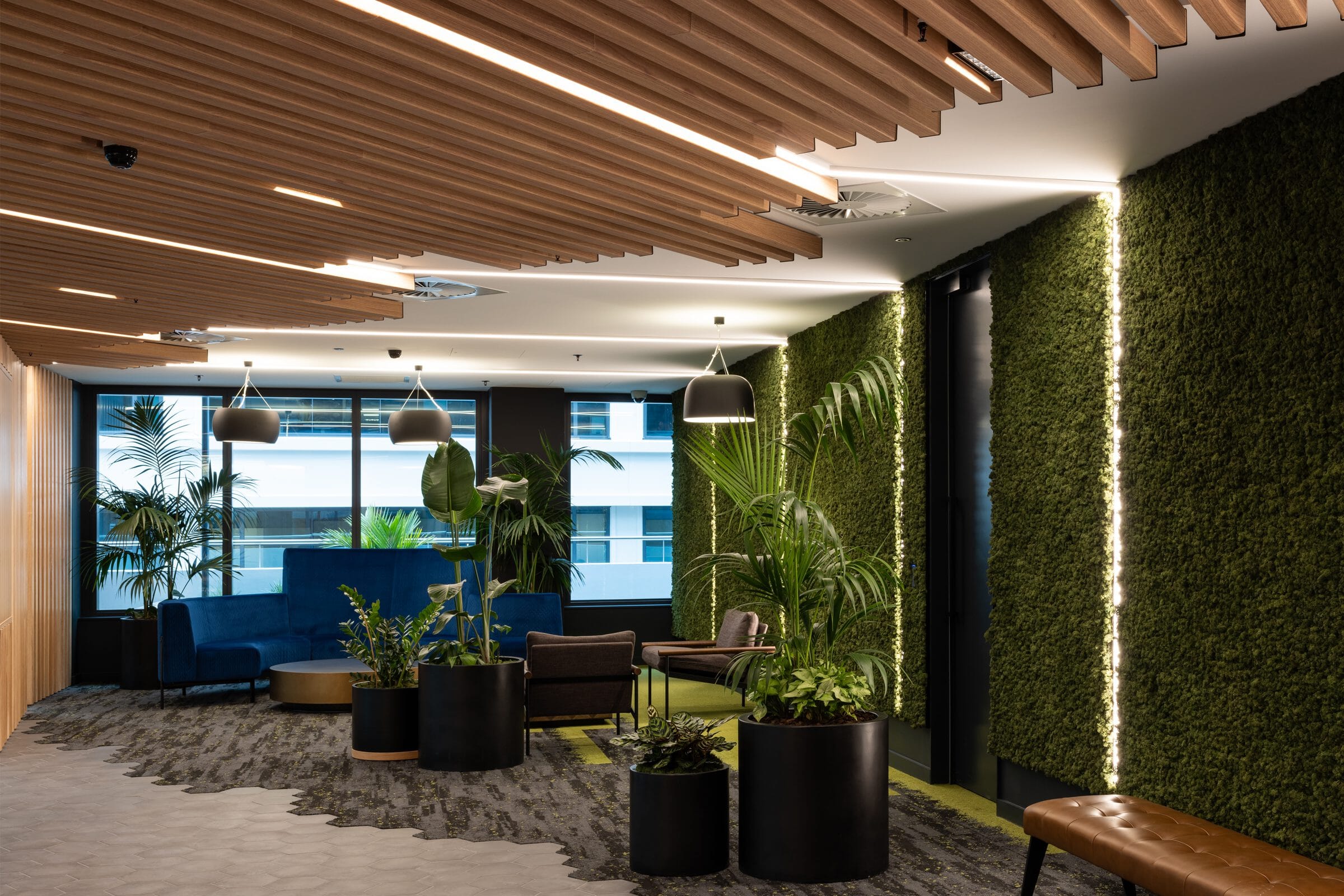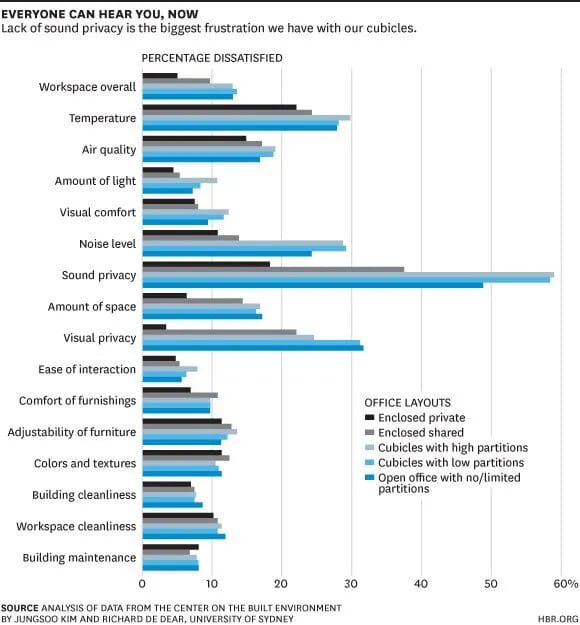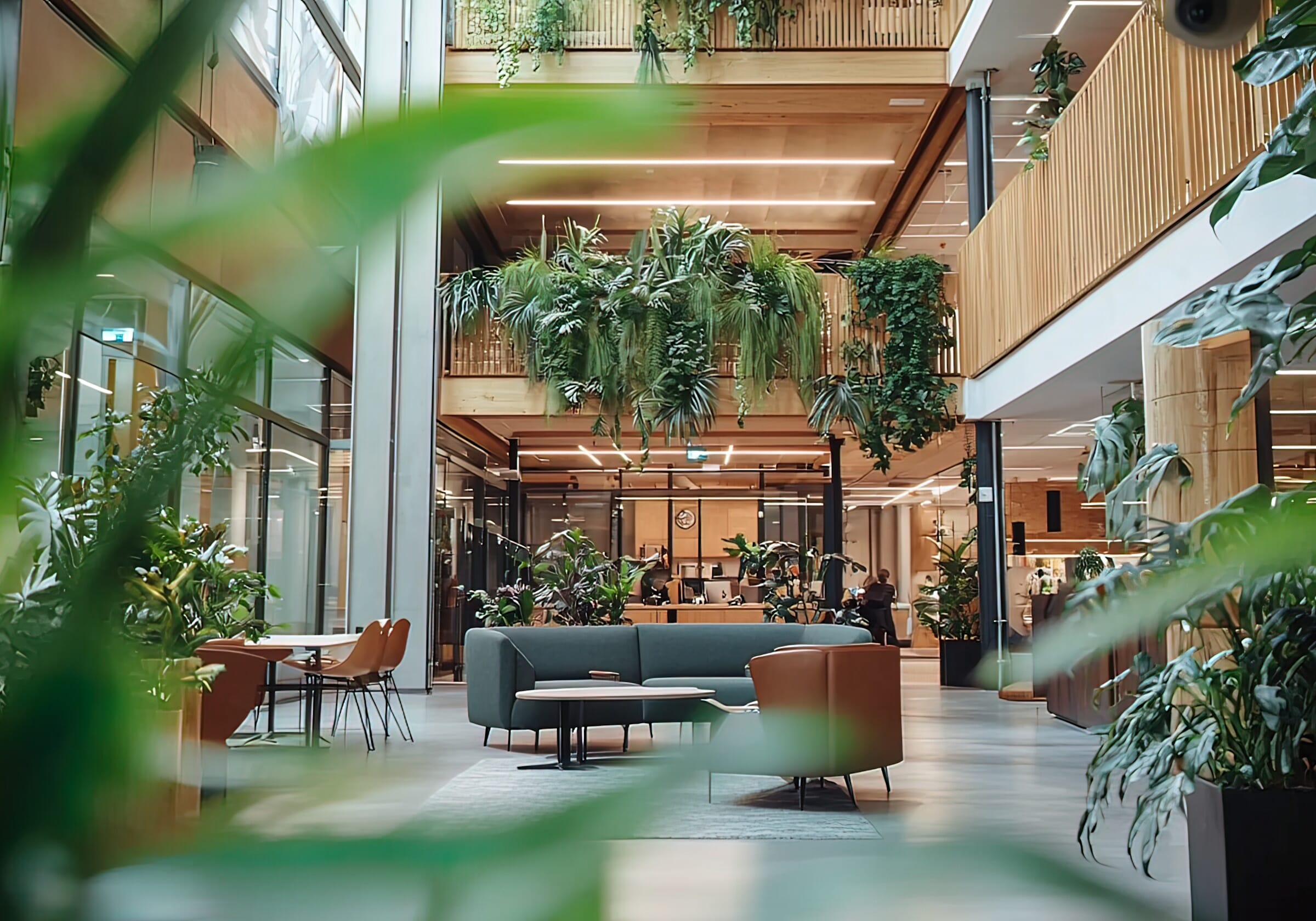
7 Minute Read
Biophilic Design – The New Way To Reduce Office Noise?
Connecting with nature brings a range of physiological benefits for humans. It is no wonder then that the latest architectural trend aims to bring the outdoors inside but one overlooked advantage is it's role in improving acoustic comfort.
Categories
Advice
TL;DR – Summary
In today’s workplaces, wellbeing and productivity aren’t just shaped by furniture and tech—your acoustic environment plays a major role. Biophilic design, with its use of plants and natural elements, doesn’t just make an office feel calmer; it actively improves how a space sounds. Poor acoustics can lead to distracted teams, lower focus, and overall dissatisfaction, while incorporating greenery helps reduce noise, enhance comfort, and support a healthier, more effective work environment. This can lead to:
- Improved focus and concentration
- Higher employee satisfaction
- Reduced stress and cognitive fatigue
- More comfortable, balanced workspaces
What is Biophilic Design?
Biophilic office design is an architectural trend focused on reconnecting workers with the natural world. With the average UK office worker spending just 7% of their time outdoors during the working week, it’s no surprise that incorporating nature into our interior environments has gained momentum.
Biophilic design draws on the idea that humans have an innate connection to nature. By integrating natural elements, like light, water and greenery, we can improve focus, boost creativity and reduce stress. While the psychological and physiological benefits of plants are well documented, one often overlooked advantage is their role in improving acoustic comfort.
The Effect Of Biophilic Design on Acoustics and Interior Noise Levels
From stress reduction to increased happiness and productivity, there is a wealth of evidence supporting the benefits of Biophilic Design.
One of the often overlooked benefits, however, is acoustics.
While biophilic design can undoubtedly make a happier office worker, what is making office workers unhappy in the first place?
A 2013 study out of the University Of Sydney found that the greatest cause of dissatisfaction amongst workers across all office types was the lack of sound privacy.
This was followed by temperature, visual privacy, and noise level.
The good news is that Biophilic Design can improve all these factors.
The benefits of green walls and roofs on a building’s energy performance are well documented. One study from the Australian Government revealed that green roofs can be up to 20.5°C lower in summer months when compared to uninsulated steel roofs.
Plants, of course, can also provide visual privacy.
Of even greater importance, however, is the ability of plants to reduce noise levels.

How Do Plants Regulate Noise?
The acoustic benefits of plants and shrubbery have only recently come into the line of sight of acousticians, spurred on by a handful of researchers who have highlighted the ability of greenery to regulate sound.
One study tested the acoustic properties of modular green walls using two different reverberation chambers. It showed that green walls, when compared to untreated walls, resulted in “a weighted sound reduction index (Rw) of 15db and a weighted sound absorption coefficient (a) of 0.40”.
The study demonstrated that the green wall showed a similar or better acoustic absorption coefficient than other common building materials, and its effects on low frequencies were of particular interest. This points to new uses for green walls in public places such as restaurants, workplaces, and hotels.
But just how do plants manage noise?
Plants are naturally suited to managing sound. Their uneven, dynamic structures make them excellent at absorbing and diffusing noise, particularly in open-plan environments where hard surfaces dominate.
-
- Sound Diffusion: When sound waves encounter a dynamic or uneven surface, like leaves or branches, they scatter evenly around a room, reducing the intensity of noise. This creates a softer, more even acoustic environment.
-
- Sound Absorption: The flexible structure of plants helps absorb sound waves. Similar to acoustic panels, plants transform sound energy into heat, reducing the amount of noise deflected back into a space.


What are the Benefits of Biophilic Office Design?
-
- Increased productivity → Studies have shown that adding greenery to the office can boost productivity by up to 15%, with employees reporting higher levels of engagement and satisfaction.
-
- Reduced Stress → Green spaces are linked to lower cortisol levels. The presence of plants has been shown to reduce physiological stress, improve mood and create a more calming atmosphere.
-
- Improved Health & Well-Being → Plants help purify the air, regulate temperature, and improve humidity levels, creating a more comfortable work environment. Research has found a 13% improvement in mental and physical well-being, with a reduction in sick days by an average of 1.6 days per person, per year.
Ideal Placement of Plants in the Office
To maximise the acoustic benefits of biophilic design, thoughtful placement is key. Here are a few practical considerations:
- Use modular green walls that are specifically designed with acoustic properties in mind.
- Opt for larger potted plants in deeper containers, which offer a greater surface area for sound absorption.
- Group plants together to create dense, sound-absorbing clusters rather than scattering them individually.
- Use shrubs and tall plants as natural partitions in open-plan spaces, helping to break up sound pathways.
- Place greenery at reflection points, such as corners or near hard surfaces, where sound is most likely to bounce and echo.
Incorporating plants into your office design isn’t just a nod to aesthetics—it’s a functional choice that supports wellbeing, boosts focus and helps control disruptive noise. With the right biophilic strategy, it’s possible to create a workplace that feels more balanced and comfortable.


Corroborating Biophilic Design
-
- One study from the University of Queensland School of Psychology examined the impact of ‘lean’ versus ‘green’ office space on employees from two large commercial offices in the UK and the Netherlands over a two month period. It concluded that an office enriched with plants makes staff happier and boosts productivity by 15%.
-
- Similarly, a 2015 report by Human Spaces found that workers with access to natural light and greenery reported a 13% higher level of well-being. Rather bleakly, the report also revealed that across Europe, the Middle East and Africa, 42% of workers had no access to natural light in their workspaces, 55% no greenery and 7% had no windows.
-
- In 2003, Genzyme Corporation designed a new corporate headquarters in Cambridge, Massachusetts, which achieved LEED’s Platinum Status. Features of the building include “natural light; a clear glass exterior; a central atrium with chandeliers at the base, which reflect sunlight; indoor gardens, and windows”. 18 months after the structure opened, a survey found that 88% said having direct views and access to the natural elements indoors improved their sense of well-being. Additionally, 75% said the building’s design increased their feeling of connection to their colleagues.
-
- A 2013 study out of the University of Essex found that visual exposure to the natural environment can reduce blood pressure and heart rate following exposure to a stressor. The study was carried out by comparing the physiological responses in humans to the built and natural environments following external stressors.
-
- If that doesn’t prick up the ears of business owners, then perhaps this will. A case study of an administrative office building at the University of Oregon found that workers with access to views of trees and landscapes took 10% fewer sick days than workers with ‘unnatural’ views. The study compared 30% of offices that overlooked trees and manicured landscapes with 31% that overlooked a street, building, and parking lot, and 39% offering no outside view at all. Workers with natural views took 57 hours of sick leave per year, compared with 68 hours for those with no view. The study also monitored the workers’ break patterns and found that those with landscape views sat at their desks for longer while those with no view took exterior walks and longer breaks.
-
- A detailed list of the health benefits of biophilic design can be seen in the table below from Terrapin Bright Green from their 2014 report ’14 Patterns of Biophilic Design’.